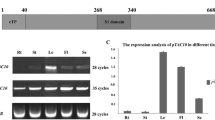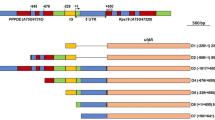Abstract
The nucleotide sequence of a cDNA clone fromArabidopsis thaliana ecotype Columbia was determined, and the corresponding amino sequence deduced. The open reading frame encodes a protein, AtJ1, of 368 residues with a molecular mass of 41 471 Da and an isoelectric point of 9.2. The predicted sequence contains regions homologous to the J- and cysteine-rich domains ofEscherichia coli DnaJ, but the glycine/phenylalanine-rich region is not present. Based upon Southern analysis,Arabidopsis appears to have a singleatJ1 structural gene. A single species of mRNA, of 1.5 kb, was detected whenArabidopsis poly(A)+ RNA was hybridized with theatJ1 cDNA. The function ofatJ1 was tested by complementation of adnaJ deletion mutant ofE. coli, allowing growth in minimal medium at 44°C. The AtJ1 protein was expressed inE. coli as a fusion with the maltose binding protein. This fusion protein was purified by amylose affinity chromatography, then cleaved by digestion with the activated factor X protease. The recombinant AtJ1 protein was purified to electrophoretic homogeneity.In vitro, recombinant AtJ1 stimulated the ATPase activity of bothE. coli DnaK and maize endosperm cytoplasmic Stress70. The deduced amino acid sequence of AtJ1 contains a potential mitochondrial targeting sequence at the N-terminus. Radioactive recombinant AtJ1 was synthesized inE. coli and purified. When the labeled protein was incubated with intact pea cotyledon mitochondria, it was imported and proteolytically processed in a reaction that depended upon an energized mitochondrial membrane.
Similar content being viewed by others
Abbreviations
- MBP:
-
maltose binding protein
- PCR:
-
polymerase chain reaction
- Stress70c:
-
the cytosolic member of the 70 kDA family of stress-related proteins
References
Baykov AA, Evtushenko OA, Avaeva SM: A malachite green procedure for orthophosphate determination and its use in alkaline phosphatase-based enzyme immunoassay. Anal Biochem 171: 266–270 (1988).
Becker J, Craig EA: Heat shock proteins as molecular chaperones. Eur J Biochem 219: 11–23 (1994).
Bork P, Sander C, Valencia A: A module of the DnaJ heat shock proteins found in malaria parasites. Trends Biochem Sci 17: 129 (1992).
Bradford MM: A rapid and sensitive method for quantitation of microgram quantities of protein utilizing the principle of protein-dye binding. Anal Biochem 72: 248–254 (1976).
Caplan AJ, Cyr DM, Douglas MG: Eukaryotic homologues of Escherichia colidnaJ: a diverse protein family that functions with HSP70 stress proteins. Mol Biol Cell 4: 555–563 (1993).
Caplan AJ, Douglas G: Characterization of YDJ1: a yeast homologue of the bacterial DnaJ protein. J Cell Biol 114: 609–621 (1991).
Clarke S: Protein isoprenylation and methylation at carboxylterminal cysteine residues. Annu Rev Biochem 61: 355–386 (1992).
Cyr DM, Lu X, Douglas MG: Regulation of eukaryotic hsp70 function by a dnaJ homologue. J Biol Chem 267: 20927–20931 (1992).
Gavel Y, von Heijne G: Cleavage-site motifs in mitochondrial targeting peptides. Prot Enging 4: 33–37 (1990).
Geladopoulos TP, Sotiroudis TG, Evangelopoulos AE: A malachite green colorimetric assay for protein phosphatase activity. Anal Biochem 192: 112–116 (1991).
Georgopoulos C, Welch WJ: Role of the major heat shock proteins as molecular chaperones. Annu Rev Cell Biol 9: 601–634 (1993).
Gupta RS, Golding GB: Evolution of HSP70 gene and its implications regarding relationships between archaebacteria, eubacteria, and eukaryotes. J Mol Evol 37: 573–582 (1993).
Hendrick JP, Hartl F-U: Molecular chaperone functions of heat-shock proteins. Annu Rev Biochem 62: 349–384 (1993).
Hendrick JP, Langer T, Davis TA, Hartl F-U, Wiedmann M: Control of folding and membrane translocation by binding of the chaperone DnaJ to nascent polypeptides. Proc Natl Aca Sci USA 90: 10216–10220 (1993).
von Heijne G: Mitochondrial targeting sequences may form amphiphilic helices. EMBO J 5: 1335–1342 (1986).
von Heijne G, Stepuhn J, Herrmann RG: Domain structure of mitochondrial and chloroplast peptides. Eur J Biochem 180: 535–545 (1989).
Kang PJ, Craig EA: Identification and characterization of a newEscherichia coli gene that is a dosage-dependent suppressor of adnaK deletion mutant. J Bact 172: 2055–2064 (1990).
Langer T, Lu C, Echols H, Flanagan J, Hayer MK, Hartl F-U: Successive action of DnaK, DnaJ and GroEL along the pathway of chaperone-mediated protein folding. Nature 356: 683–689 (1992).
Liberek K, Marszalek J, Ang D, Georgopoulos C, Zylicz M:Escherichia coli DnaJ and GrpE heat shock proteins jointly stimulate ATPase activity of DnaK. Proc Natl Acad Sci USA 88: 2874–2878 (1991).
Liberek K, Skowyra D, Zylicz M, Johnson C, Georgopoulos C: TheEscherichia coli DnaK chaperone, the 70-kDa heat shock protein eukaryotic equivalent, changes conformation upon ATP hydrolysis, thus triggering its dissociation from a bound target protein. J Biol Chem 266: 14491–14496 (1991).
Lindquist S: The heat shock response. Annu Rev Biochem 55: 1151–1191 (1986).
Maniatis T, Fritsch EF, Sambrook J: Molecular Cloning: A Laboratory Manual, vols 1–3. Cold Spring Harbor Laboratory Press, Cold Spring Harbor, NY (1989).
McNeil PH, Thomas DR: The effect of carnitine on palmitate oxidation by pea cotyledon mitochondria. J Exp Bot 27: 1163–1180 (1976).
Miernyk JA: Extracellular secretion of acid hydrolases by maize endosperm cells grown in liquid medium. J Plant Physiol 129: 19–32 (1987).
Miernyk JA, Duck NB, ShattersJr RG, Folk WR: Hsc70 can act as a molecular chaperone during the membrane translocation of a plant secretory protein precursor. Plant Cell 4: 821–829 (1992).
Ohtsuka K: Cloning of a cDNA for heat shock protein hsp40, a human homologue of bacterial DnaJ. Biochem Biophys Res Commun 197: 235–240 (1993).
Palleros DR: DnaK ATPase activity revisited. FEBS Lett 36: 124–128 (1993).
Preisig-Muller R, Kindl H: Plant dnaJ homologue: molecular cloning, bacterial expression, and expression analysis in tissues of cucumber seedlings. Arch Biochem Biophys 305: 30–37 (1993).
Preisig-Muller R, Muster G, Kindl H: Heat shock increases the amount of prenylated DnaJ protein at membranes of glyoxysomes. Eur J Biochem 219: 57–63 (1994).
Riedell WE, Miernyk JA: Glycoprotein synthesis in maize endosperm cells. The nucleoside diphosphate-sugar: dolicholphosphate glycosyltransferases. Plant Physiol 87: 420–426 (1988).
Rowley N, Prip-Buus C, Westerman B, Brown C, Schwarz E, Barrell B, Neupert W: Mdjlp, a novel chaperone of the DnaJ family, is involved in mitochondrial biogenesis and protein folding. Cell 77: 249–259 (1994).
Silver PA, Way JC: Eukaryotic DnaJ homologs and the specificity of Hsp70 action. Cell 74: 5–6 (1993).
Straus D, Walter W, Gross CA: Dnak, DnaJ, and GrpE heat shock proteins negatively regulate heat-shock gene expression by controlling the synthesis and stability of sigma 32. Genes Devel 4: 2202–2209 (1990).
Thomas DR, Noh Hj Jalil M, Cooke RJ, Yong BSC, Ariffin A, McNeil PH, Wood C: The synthesis of palmitoylcarnitine by etio-chloroplasts of greening barley leaves. Planta 154: 60–65 (1982).
Wall D, Zylicz M, Georgopoulos C: The NH2-terminal 108 amino acids of theEscherichia coli DnaJ protein stimulate the ATPase activity of DnaK and are sufficient for lambda replication. J Biol Chem 269: 5446 (1994).
Welch W, Feramisco JR: Rapid purification of mammalian 70 000-dalton stress proteins: affinity of the proteins for nucleotides. Mol Cell Biol 5: 1229–1237 (1985).
Zhou R, Hayman GT, Kroczynska B, Miernyk JA:AtJ2, anArabidopsis homologue ofEscherichia coli dnaJ. Plant Physiol 108: 821–822 (1995).
Zhou R, Miernyk JA: ATPase activities of the maize Stress70 molecular chaperone proteins. J Biol Chem, in press (1996).
Zhu J-K, Shi J, Bressan RA, Hasegawa PM: Expression of anAtriplex numularia gene encoding a protein homologous to the bacterial molecular chaperone DnaJ. Plant Cell 5: 341–349 (1993).
Zhu J-K, Bressan RA, Hasegawa PM: Isoprenylation of the plant molecular chaperone ANJ1 facilitates membrane association and function at high temperature. Proc Natl Acad Sci USA 90: 8557–8561 (1993).
Zylicz M, Yamamoto T, McKittrick N, Sell S, Georgopoulos C: Purification and properties of the dnaJ replication protein ofEscherichia coli. J Biol Chem 260: 7591–7598 (1985).
Author information
Authors and Affiliations
Rights and permissions
About this article
Cite this article
Kroczynska, B., Zhou, R., Wood, C. et al. AtJ1, a mitochondrial homologue of theEscherichia coli DnaJ protein. Plant Mol Biol 31, 619–629 (1996). https://doi.org/10.1007/BF00042234
Received:
Accepted:
Issue Date:
DOI: https://doi.org/10.1007/BF00042234




